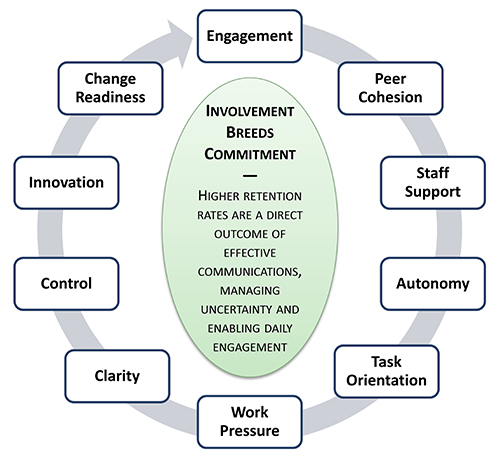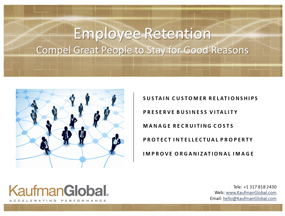Five Reasons for Better Employee Retention
The cost of poor employee retention is significant and ever increasing. The ability to retain good people is a huge competitive advantage. Whether the market is going up or down, turnover is a factor for all employers, no matter what your business.
Not sure retention is an area you really need to spend energy on? Consider this… with strong employee retention strategies and tactics, you:
- Avoid predictable re-staffing costs and gaps
- Guard intellectual property drain
- Preserve customer relationships
- Don’t enable your competitors
- Develop positive buzz about your organization
Those are some pretty critical wins. And, they all contribute to significantly better business performance. So why not do it right? And by right, we don’t just mean pay increases, stock options and / or bonuses. These pieces alone won’t solve your retention issues. It’s not all about the money… really. While financial incentives can buy some time, they do little to build confidence in the culture of the organization and the enterprise. A low retention rate is always a symptom of other issues.
Without a practical employee retention strategy in place, organizations find themselves parting with a higher portion of their best and most qualified talent, the result of which is losses in productivity, time and money. So how do you stop the bleeding? First, focus on the heart of the issue… people.
The Most Important Employee Retention Factor is Engagement

This chart shows characteristics that frame highly-retentive workplaces
The number one place where organizations get it wrong is engagement. That’s right, when people leave, it’s most often because they did not feel a sense of accomplishment or belonging. People want to feel like they are part of something. For decades, surveys have concluded that compensation and benefits, while important, always rank lower than belonging and the ability to contribute meaningfully when it comes to job satisfaction. Don’t ignore this!
What to Do
There are plenty of ways to improve retention by getting (and keeping) people engaged. Start by including people in improvement activities like process mapping – those working inside the process always know the most about value and waste where they work – this is their chance to contribute their knowledge! Engaging them in the hands-on work of fixing identified improvements should follow via small focused projects (Kaizen Events and Rapid Improvement Events). To ensure energy and support for these efforts, leaders should receive training and alignment coaching to help them understand that it’s OK to give up some control and let the organization contribute more from the frontlines.
To move beyond a project-based approach to engagement, consider the structure and discipline embodied in Kaufman Global’s Lean Daily Management System®. This is the real deal when it comes to sustainment and a structure that keeps people involved on a day-to-day basis within their workgroups.
 Supplemental Reading Recommendation:
Supplemental Reading Recommendation:
White Paper | Engage the Organization and a Performance Culture Will Follow
When an organization is formally and consistently engaged, a culture of performance follows. Understanding how to achieve a performance culture, why it’s so elusive for many leaders and their organizations, and what it takes to make it reliable is the key to sustainable improvement.








